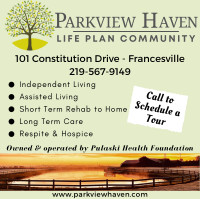"We want to make sure everyone in the county has an opportunity to see the maps and comment on them," Good said.
Demands on rural land are increasing. There are needs for industry, wind development, and retirees wanting a peaceful country home. Pulaski County will continue to have a need for crop and livestock farming as well.
It’s time to take a fresh look at priorities. There are several reasons for county residents to take that look themselves. Here are just a few.
- If we don’t plan for ourselves, someone bigger may do it for us.
- A plan gives elected officials a framework for making decisions.
- Government organizations prefer to give grant money to communities with a vision.
- Industry is attracted to communities that have a vision for their own future.
With these thoughts in mind, in 2009 the Pulaski County Plan Commission held a public hearing regarding proposed ordinances, including land use, subdivision, wind energy and right to farm. That hearing generated a great deal of interest. Because of comments received, modifications were made to those proposed ordinances, and they will again be presented to the County Commissioners for consideration.
Thursday's public hearing provided time for the plan commission to receive input on the zoning maps that will accompany the proposed ordinances.
Following the opening statement, the public was invited to view the maps and, if questions or issues were raised, to leave written comments. These comments will be considered by the Plan Commission at the next regularly scheduled meeting following this public hearing. All written comments will be considered, as long as those making written comments have signed in and have presented their residential address and/or the address of land owned in Pulaski County.
The public is invited to view the proposed maps - and the ordinances as previously proposed and revised - at the following locations:·
- Online at http://pulaskionline.org/ (click on the Economic Development tab)·
- Hard copies at the Pulaski County Public Library, Winamac & Medaryville branches.·
- Hard copy at the Monterey Public Library.·
- Hard copy at the Francesville Public Library.·
- Hard copy at the Auditor’s Office in the Courthouse.
Submitted on behalf of the Pulaski County Plan Commission, Kathi Thompson, Secretary
Background Information on Land Use Planning
The following information is taken from Purdue University Cooperative Extension Service ID-224, Plan Commission Public Hearings: A Citizen’s Guide, written by Scott Hutcheson, Leadership & Community Development Specialist.
Whether for retirement, a child’s college education, or an upcoming vacation, planning for the future requires some time and energy. For a community, one of the ways to plan for the future is to make good decisions about how land is used and the ways in which our communities will grow.
In most Indiana communities the local plan commission has this responsibility, and an important component of the planning process is the involvement of local citizens. The public hearing is one way for citizens to become involved in land use and community planning decisions.
If you have never attended a public hearing, any impressions you have of them may have been shaped by local media coverage of hearings that have gotten “out of hand.” In some communities, public hearings could even be described as frustrating “gripe sessions” or perfunctory legal hoops that must be jumped through rather than vibrant examples of citizen democracy.
Perhaps the phrase “public listening” better describes what ideally should take place at a public hearing: all parties— commission members, petitioners, opponents, proponents—together listening to one another, weighing all the options, and arriving at and supporting decisions that promote the overall common good of the public.
Sound idealistic? Sure, but the public hearing is democracy at work, and the very nature of democracy is rooted in idealism. Just as two persons, no matter how good their friendship, can always strive for a better relationship, we, too should strive for better expressions of the democratic ideal. It is possible that at times, no amount of public discussion, no matter how well reasoned, will change opinions and votes, but is the alternative—no public discussion—a better approach?
Who’s Who in the Planning Process
Before discussing the three major players in the planning process, a little bit of history may help to provide a backdrop for current-day planning practices. The legal history of planning in Indiana goes back to 1947, when enabling legislation was passed that gave local communities the authority to establish plan commissions to guide and direct development in their jurisdictions. This was called the “Advisory Plan Law.” Additional laws were passed in 1957 (Area Planning Law) and 1981 (Metropolitan Planning Law).
The current Indiana laws for planning and zoning are organized under Indiana Code 36-7-4. There are 12 different series under this code (The Community Planning Handbook, 1993). These statutes describe three public bodies that are the main actors in the planning process. These are the legislative body, the plan commission, and the board of zoning appeals.
The Legislative Body
The legislative body may be a city council, town council, or board of county commissioners. {In Pulaski County, this body is the board of county commissioners.} (This body is) responsible for setting the planning process in motion.
The Plan Commission
Most Indiana cities, towns, and counties have a group of citizens that help carry out responsibilities related to how land is used in their community. This group, the plan commission, is the unit of local government with authority for developing comprehensive planning and zoning.
Cities, towns, and counties may each have plan commissions. (In Pulaski County there are) multiple plan commissions operating within the geographic area of (the county). (The towns of Winamac and Francesville have plans in place the cover their geographic boundaries plus two miles.)
It is important to understand that the plan commission is an advisory board. Primarily, it is an advisor to the legislative body. Plans and proposals from individuals and groups such as businesspeople, developers, manufacturers, private citizens, and governmental units come first to the plan commission.
An important function of the plan commission is the development of the comprehensive plan, sometimes called the “master plan.” A comprehensive plan is a document, or series of documents, prepared by the plan commission, that establishes policies for the future development of the community.
In its role as an advisory body, the plan commission recommends the comprehensive plan to the legislative body. The plan commission also makes recommendations to the legislative body regarding zoning and subdivision control ordinances (The Community Planning Handbook, 1993). The commission is a decision-making body for subdivisions of land.
Board of Zoning Appeals
Any community that has adopted zoning ordinances also has a board of zoning appeals. This quasi-judicial body provides a “safety-valve” through which landowners can seek relief from strict application of a zoning ordinance. The primary function of this board is to give greater assurance that zoning is fair and equitable, that it is properly interpreted, and that it does not cause excessive hardship (The Community Planning Handbook, 1993). The Board of Zoning Appeals acts as “gatekeeper” or guardian of the ordinances.
Participating in the Public Hearing
Participating in government can be as simple as voting at each election. For citizens interested in taking their participation a step further and becoming involved in the day-to-day process of local government, plan commissions provide such opportunities. There are several ways for local citizens to participate in the activities of the plan commission.
Finding Out About the Plan Commission
The first step is to find out when your plan commission has its regular meetings and on what special projects (e.g., updating the comprehensive plan) it might be working. (In Pulaski County, meetings are advertised in the local newspapers, or you can call the Auditor’s Office for a schedule.)
Indiana’s Open Door Law
The plan commission meetings are open to the public, as are the meetings of most public agencies, although this has not always been the case. While some communities have a long legacy of public accessibility and citizen involvement, there are other communities with a history of closed-door decision-making.
In 1977, when Indiana’s Open Door Law was passed, all public agency meetings at which “official actions” were taken became legally open to the public. According to the Open Door Law, a “meeting” is a gathering of a majority of the governing body of a public agency for the purpose of taking official action upon business (IC 5-14-1.5.1). “Official action,” according to the Open Door Law, means to receive information, deliberate, make recommendations, establish policy, make decisions, or take final action.
The Open Door Law lists four types of gatherings that are not considered “meetings.” A meeting does not include (1) any social or chance gathering not intended to avoid the requirements of the Open Door Law; (2) any on-site inspection of a project or program; (3) traveling to and attending meetings of organizations devoted to the betterment of government; or (4) a caucus (Indiana Attorney General Modisett, 1997).
Plan Commission Decisions Requiring Public Hearings
In a public meeting of the plan commission, the public may attend and observe, but not necessarily participate. The public hearing, on the other hand, is the mechanism for the public to provide comment. The express purpose of a plan commission public hearing is to receive written and oral testimony on specific matters (Allor, 1984). Some plan commissions allow the public to comment on any agenda item at any time during a meeting; others allow comment only during formal public hearings (Bergman, 1998).







